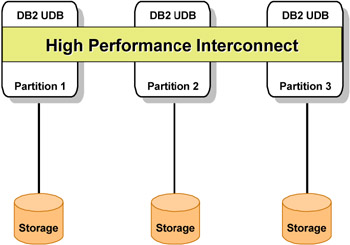1.4 Parallel database architecture
|
| < Day Day Up > |
|
1.4 Parallel database architecture
Both Oracle and IBM offer parallel architecture or clustering environments for their databases in order to provide customers with the ability to support very large databases (VLDB). This is achieved by partitioning the database over multiple nodes or servers. Oracle offers Real Application Cluster (RAC) formerly known as Oracle Parallel Server, and IBM offers DB2 UDB ESE with the Database Partitioning Feature (DPF), formerly known as DB2 UDB Extended Enterprise Edition (EEE).
There are three major architectures used to implement a partitioned environment Shared memory, Shared disk and Shared nothing. This book briefly discusses both Shared disk (Figure 1-13) and Shared nothing (Figure 1-14) architecture. Table 1-4 shows the differences of both technologies.

Figure 1-13: Shared disk architecture

Figure 1-14: Shared nothing architecture
| Shared disk Architecture | Shared nothing architecture |
|---|---|
| Requires special hardware | Does not require special hardware |
| Non linear scalability | Provides near linear scalability |
| Balanced CPU or node fail-over | Balanced/Unbalanced CPU or node fail-over |
| Requires CPU level communication at disk access | Minimal communication |
| Non disruptive maintenance | Non disruptive maintenance |
1.4.1 Real Application Clusters
Real Application Clusters (RAC) is Oracle 9i's clustering technology, which provides an environment capable of supporting large databases. RAC is based on a shared disk architecture aimed at achieving high availability of a distributed environment.
RAC is an extension to the Oracle database, which enables building a multi node database environment. RAC requires an Oracle database, and the clustering technology provided by the platform vendor in order to achieve successful installation and implementation.
RAC consists of three major components: nodes containing CPUs, cluster interconnect, and storage units. The nodes are processing nodes. Typically, every node is a symmetric multi processing node (SMP). As shown in Figure 1-13, in a shared disk environment every processing node has access to every storage unit. However, every node in the cluster has its own memory, operating system, and database instance. The nodes do not share memory among each other.
1.4.2 DB2 UDB ESE with the Database Partitioning Feature
IBM Data management software extends DB2 UDB to the parallel multi node environment in order to provide a scalable solution capable of supporting large amounts of data.
The partitioning feature in DB2 UDB is based on a shared nothing architecture. As shown in Figure 1-14, every node in the cluster has its own dedicated memory, operating system, and storage units. An application of a shared nothing architecture is aimed at achieving high scalability and improving performance. This option in DB2 UDB ESE DPF does not require any clustering technologies to run. However, a high availability solution can be implemented in conjunction with the clustering technology provided by the platform vendor.
DB2 UDB ESE DPF uses two levels of parallelism in order to achieve good performance:
-
Intra-partition parallelism, which is the ability to have multiple processors process different parts of an SQL query, index creation, or a database load within a database partition. This level of parallelism can be specified in the DBM configuration file by setting the INTRA_PARALLEL parameter to ON.
-
Inter-partition parallelism, which provides the ability to break up a query into multiple parts across multiple partitions of a partitioned database, on one server or multiple database servers. This can be accomplished on both SMP servers and MPP clustered servers.
|
| < Day Day Up > |
|